Cookies on GOV.UK
We use some essential cookies to make this website work.
We’d like to set additional cookies to understand how you use GOV.UK, remember your settings and improve government services.
We also use cookies set by other sites to help us deliver content from their services.
You have accepted additional cookies. You can change your cookie settings at any time.
You have rejected additional cookies. You can change your cookie settings at any time.
- Driving and road transport
- Cycling and walking

Active travel: local authority toolkit
- Department for Transport
Updated 10 August 2022
Applies to England

© Crown copyright 2022
This publication is licensed under the terms of the Open Government Licence v3.0 except where otherwise stated. To view this licence, visit nationalarchives.gov.uk/doc/open-government-licence/version/3 or write to the Information Policy Team, The National Archives, Kew, London TW9 4DU, or email: [email protected] .
Where we have identified any third party copyright information you will need to obtain permission from the copyright holders concerned.
This publication is available at https://www.gov.uk/government/publications/active-travel-local-authority-toolkit/active-travel-local-authority-toolkit
Walking, wheeling and cycling are the least carbon-intensive ways to travel.
However, walking currently accounts for only 5% of the total distance travelled in England. Around 49% of trips in towns and cities under 5 miles were made by car in 2021, with around a quarter of all car trips in England less than 2 miles.
Many of these trips could be walked, wheeled or cycled, which would help to reduce the 68 megatons ( Mt ) carbon dioxide equivalent (CO2e) emitted from cars in 2019. This would benefit local economies, as well as improve people’s health.
More active travel will also make roads quieter, safer and more attractive for people to walk, wheel and cycle – a virtuous cycle.
As we decarbonise transport, making all cars, public transport and heavy goods vehicles (HGVs) zero emission is part of the solution, but relying solely on zero emission road vehicles isn’t enough.
Road traffic, even on pre-COVID-19 trends, was predicted to grow by 22% from 2015 to 2035, much of it in cities where building new roads is physically difficult and disadvantages communities.
As set out in the second cycling and walking investment strategy (CWIS2), the government wants walking, wheeling and cycling to be the natural first choice for shorter journeys or as part of longer journeys.
Local authorities can play an important role in increasing walking, wheeling and cycling. Through influencing planning and taking a wider, strategic view of travel infrastructure across their area, authorities can ensure that active travel infrastructure connects residents to services.
As local leaders, authorities have a wide sphere of influence and can lead by example in adopting, promoting and providing infrastructure to enable and encourage active travel with their staff.
Authorities can also work with local businesses, industrial estates and business improvement districts to design specific interventions and behaviour change programmes to enable active travel with their employees and customers.
The primary actions for local authorities are to:
- develop Local Cycling and Walking Infrastructure Plans (LCWIPs)
- develop and implement Travel Demand Management Plans
- plan for and improve active travel infrastructure
- promote behaviour change to enable active travel
What active travel means
Active travel refers to modes of travel that involve a level of activity.
The term is often used interchangeably with walking and cycling, but active travel can also include trips made by wheelchair, mobility scooters, adapted cycles, e-cycles, scooters, as well as cycle sharing schemes (adapted from the definition in the Future of Mobility: urban strategy .
Wheels for Wellbeing explains that cycling includes a wide range of cycle types, including:
- recumbent tricycles
- cycles for 2 (tandem, side by side, wheelchair tandem and duet bikes)
Recent changes in active travel
The 2021 National Travel Survey found that the number of walking trips remained at a similar level to 2020, which is below the level seen in recent years prior to the pandemic. Whilst overall levels of walking have fallen in recent years, people are choosing to walk further, with walking trips of over a mile remaining higher than pre-pandemic years.
Cycling decreased back towards pre-pandemic levels, following a peak during 2020. The National Travel Survey reported that:
- 47% of people over 5 years had access to a pedal cycle, the same level as 2020
- less people (a decrease of 27%) cycled for part of their trip, and the average number of trips by cycle decreased by 27%
- following the peak of average miles cycled per person in 2020, average miles decreased by 37% in 2021 – bringing it back to pre-pandemic levels
Wave 5 of the National Travel Attitude Survey focused on cycling with:
- off-road and segregated cycle paths (55%), safer roads(53%) and well-maintained surfaces (49%) the most common measures that respondents said would encourage them to cycle more
- 64% supporting the creation of dedicated cycle lanes, at the expense of road space for cars
E-cycles are growing in popularity and make cycling accessible to more people, build users’ confidence and enable cycling in more challenging terrain.
The definition of e-cycle includes all electrically assisted pedal cycles, electric cycles, e-bikes and e-trikes.
E-cycles offer assistance only when the rider is pedalling and must comply with the electrically assisted pedal cycles (EAPCs) regulations .
To be classified as an EAPC and not treated as a motor vehicle, when used on roads, a cycle fitted with an electric motor must comply with the requirements of the EAPC Regulations 1983. Specifically:
- it must be fitted with pedals that are capable of propelling it
- the maximum continuous rated power of the electric motor must not exceed 250 watts
- electrical assistance must cut off when the vehicle reaches 15.5 miles an hour
Cycle sharing
Cycle sharing describes any setting where cycles can be borrowed by the public or an employee (for workplace schemes).
Cycle sharing schemes can be an effective way to re-engage people in cycling – in CoMoUK’s 2021 bike share report nearly half of the 4,000 respondents said that joining a scheme was a catalyst to them cycling for the first time in at least a year, and 24% of them had not cycled for 5 years or more.
CoMoUK offers more information and guidance on cycle sharing schemes and identifies different scheme types:
- public – growing rapidly, these can include e-cycles. They integrate well with other modes of transport and are established in Belfast, Brighton, Cardiff, Glasgow, Liverpool and London and smaller locations such as Hereford, Guildford, and Stirling. Existing schemes in the UK can be found on CoMoUK’s map
- station-based – cycles are located at train stations and at various points across the town or city, at staffed or unstaffed hubs, docking stations or in a geo-fenced area. Some can be returned to any dock and others must be returned to the starting location
- free-floating – where cycles can be left anywhere within the urban boundary, often with guidance on not causing obstructions when parking
- cycle libraries – allow users to rent cycles for short periods and include cycle hubs in community locations (such as libraries and sports centres)
- peer-to-peer – where owners rent their cycle out for a fee
- pool cycles – generally housed at workplaces or community locations and borrowed by members of staff or the community. These schemes may share public facilities such as cycle storage
Implementing active travel: cycle sharing in Scotland
In 2020, the grant programme Paths for All, Smarter Choices, Smarter Places , in Edinburgh and Glasgow, worked to increase the uptake of cycle-sharing. This generated almost 18,000 new users and a 38% increase in trips in 3 months.
Users reported an improvement in their physical and mental health, and 10% went on to buy their own cycle. Further details are available from CoMoUK .
The benefits of active travel
Encouraging mode shift to walking, wheeling and cycling is one of the most cost-effective ways of reducing transport emissions, as outlined in the transport decarbonisation plan.
Walking, wheeling and cycling can decrease congestion, air and noise pollution, and both are linked to health and economic benefits.
Friends of the Earth produced a briefing on the role and benefits of segregated cycleways and e-cycles in urban areas. They report that improvements could deliver benefits for health, carbon and local economies, and make recommendations to maximise the effectiveness of funding.
Carbon emissions and air pollution
Sustrans, the national travel charity, estimates that 28,000 to 36,000 early deaths occur each year in the UK due to air pollution worsening heart and lung disease. They report that 80% of roadside nitrogen dioxide ( NO2 ) pollution is from road transport where limits are being broken.
As more of our short journeys (48% of all trips in urban towns and cities are under 2 miles) are walked or cycled, the carbon, air quality, noise and congestion benefits will be complemented by significant improvements in public health and wellbeing.
It is estimated that active travel can deliver between 1 MtCO2e and 6 MtCO2e savings from 2020 to 2050 in the transport decarbonisation plan.
In cycle share schemes, an average of 53kg of CO2e are saved per cycle share user each year according to CoMoUK’s 2021 bike share report .
Active travel can reduce the proportion of people driving children to school by up to 33%. Through projects such as the Big Pedal , 8.5 million car miles could be saved, resulting in a decrease of 2,500 tCO2e and reductions in NO2 levels.
Future active travel spending is expected to deliver £20 million to £100 million savings from air quality improvements as well as providing opportunities to improve green space and biodiversity.
Physical health
Physical inactivity costs the NHS up to £1 billion each year , with additional indirect costs of £8.2 billion according to a report by the Department for Transport ( DfT ) in 2014 on the economic benefits of walking and cycling . This report also highlights a link between adult obesity levels and travel behaviour as countries with the highest levels of cycling and walking generally have the lowest obesity rates.
In Growing Cycle Use , the Local Government Association ( LGA ) reports that if cycling rates were elevated to London levels across other UK cities, this would avoid at least 34,000 incidences of 8 life-threatening conditions between 2017 and 2040.
Regular commuting by cycle is linked to a lower risk of cancer or heart disease compared to other forms of transport. This may be partly due to cyclists and walkers being exposed to less air pollution than drivers and passengers inside vehicles on the same routes.
In the 2021 bike share report , CoMoUK found that 20% of cycle share scheme users said that if formed ‘all’ or a ‘major part’ of the physical activity they undertook.
Sustrans identifies further health benefits: a 3-mile commute will achieve recommended levels of activity each week.
The Energy Saving Trust reports that walking strengthens muscles, lungs, bones and joints.
Physical activity has also been shown to reduce incidences of heart disease, asthma, diabetes and cancer , as well as benefiting those with bad backs.
Mental health
Exercise can protect against anxiety and depression, according to the NHS . Any exercise is beneficial but exercising outdoors can have additional benefits.
Research in the British Medical Journal suggests that exercise can also help reduce stress . Guidance from the UK Chief Medical Officers’ on physical activity suggests that 30 minutes of moderate activity per day almost halve the odds of experiencing depression .
Gear Change states that completing 20 minutes of exercise each day cuts the risk of depression by 31% and increases worker productivity.
Economic benefits
Increasing active travel will reduce road congestion, particularly at peak times, leading to increased productivity and improved movement of goods and services. Sustrans estimates that congestion costs £10 billion per year in 2009 in urban areas, and that this cost could rise to £22 billion by 2025.
Living Streets’ Pedestrian Pound report outlined a range of economic benefits of walking, including that well-planned walking improvements can lead to a 40% increase in shopping footfall.
The LGA highlights how, after a Canadian council reallocated high street parking as bike lanes or cycle parking for a year, businesses benefitted from increased footfall (20% increase), spend (16% increase) and increased frequency of return visits (13% increase).
The Transport decarbonisation plan states that cycle manufacture, distribution, retail and sales contribute £0.8 billion per year to the economy and support around 22,000 jobs.
For organisations
As an employer, promoting active travel can help with corporate social responsibility, reduce the impact of business traffic (including commuting) locally and reduce demand for parking spaces.
Active travel can also improve the health and wellbeing of staff, increase productivity and motivation, and aid the recruitment and retention of skilled workers. More information is available on the Sustrans website .
Actions for local authorities
Local authorities are well placed to plan and provide space for inclusive active travel infrastructure and accompanying behavioural change programmes. For Local Transport Authorities (LTAs) and combined authorities, doing so is part of their responsibilities on highways and road safety.
The LGA , as part of their decarbonising transport series, produced guidance on how authorities can grow cycle use. They note that measures will be most effective if implemented as part of a comprehensive active travel plan, integrated with wider transport, climate and housing strategies.
The final evaluation report of the Cycle City Ambition programme makes suggestions for local policymakers and practitioners on the most effective ways to increase active travel. It found that improving infrastructure is effective in increasing cycling and improving health equity, but requires significant investment and may take some time for impacts to be fully realised.
Sustrans can assist local authorities to develop active travel policy and guidance. It can also help promote active travel and provide feedback on walking and cycling schemes. Its website has sections for professionals, policy, and a resource library to enable authorities to make the case for active travel.
Living Streets can offer specialist advice and support for local authorities on enabling walking, including school and community engagement and infrastructure design.
Wheels for Wellbeing is a national charity that supports disabled people to access and enjoy cycling. As part of its Infrastructure for All campaign , it has highlighted the most significant barriers to cycling for disabled cyclists, including inaccessible cycling infrastructure and inadequate facilities to secure adapted cycles.
It recommends that authorities looking to install or upgrade cycling infrastructure follow LTN 1/20 – Cycle Infrastructure Design Guidance or the London Cycling Design Standards inclusive cycle concept.
Wheels for Wellbeing has published a Guide to Inclusive Cycling that promotes best practice in designing inclusive cycling infrastructure.
Implementing active travel: Greater Manchester
Using funding from the Cycle Cities Ambition programme, Greater Manchester built 3 miles of cycle lanes along one of the city’s busiest bus routes in 2017 .
Infrastructure installed included a mix of on-road and fully segregated cycle lanes and shared-use paths, along with 26 bus stop bypass lanes for cyclists.
The cycling measures were planned as part of a holistic design to improve the environment and maximise opportunities for cycling, walking and improved bus travel along the corridor.
The overall scheme included widened footways and improved crossing facilities for pedestrians and the removal of general traffic from a section of the road at certain times of day, improving bus journey time reliability. Mitigation measures to address traffic displacement onto parallel routes were also introduced.
Surveys found that in 2018, cycling 2 miles from the city centre was up 85% against a 2015 baseline.
For 2018, analysis identified more than a million journeys along one section of the route, saving an estimated 873.5 tonnes of CO2 .
1. Develop a Local Cycling and Walking Infrastructure Plan
Local Cycling and Walking Infrastructure Plans (LCWIPs) are part of the 2017 cycling and walking investment strategy .
Although not mandatory, their aim is to help authorities in England take a strategic approach to improving conditions for walking and cycling and ensure that consideration is given to walking and cycling within local planning and transport policies.
Developing an LCWIP will help an authority make a strong case for future investment in active travel infrastructure. DfT has produced guidance and tools on developing an LCWIP .
The main outputs from an LCWIP are a:
- mapped network plan for walking, wheeling and cycling that identifies preferred routes, current and future travel patterns, and core zones for further development
- prioritised programme of infrastructure improvements for future investment in the short, medium and long term that contributes towards meeting broader local goals
- report that sets out the underlying analysis, including the barriers and enablers for walking, wheeling and cycling, and provides a narrative to support the improvements identified
As of September 2020, 45 of the 46 local authorities that took part in the original DfT LCWIP pilot scheme had submitted an LCWIP.
Cycling measures, infrastructure and networks identified in an LCWIP should follow the best practice guidance in Local Transport Note 1/20 on delivering high-quality cycling infrastructure.
Authorities can ensure that new infrastructure is inclusive by following the Wheels for Wellbeing guidance .
Wave 5 of the National Travel Attitudes Survey identified safety as a major concern among those who would like to cycle more often. One action to boost cycling is to provide dedicated road space for cyclists. The development of a network of high-quality, segregated cycling infrastructure, through inclusion in LCWIPs, will encourage growth.
The LGA notes that a mixture of measures is needed alongside segregated infrastructure to develop safe cycling networks , including vehicle speed and volume management.
To support the development of LCWIPs, Sustrans produced a report addressing 9 misconceptions about implementing cycling infrastructure.
For each myth, it provides evidence and sample messages to support a communications campaign and make the case for increased investment in active travel.
On 6 July 2022, DfT published the second statutory Cycling and Walking Investment Strategy (CWIS 2) , which covers the period between 2021 and 2025. The strategy includes new and updated objectives including:
- increasing levels of walking and walking to school
- doubling cycling
- increasing the proportion of journeys in towns and cities that are walked or cycled
It also sets out the funding in place to achieve these objectives.
2. Develop a Travel Demand Management Plan
LTAs in England can assist in encouraging active travel by developing a Travel Demand Management (TDM) plan.
These aim to manage pressure on a transport network under times of heightened demand and uncertainty. An effective TDM plan can contribute data to the development of an LCWIP, as well as strengthen the case for investment.
The DfT toolkit for LTAs on developing TDM plans , produced by Mott MacDonald, can be used to support LTAs in developing TDM plans following COVID-19.
The toolkit also allows authorities to manage other scenarios where there are pressures on the transport network or times of higher demand. The toolkit includes worked scenarios, a template action plan and sample questions to answer during the data-gathering exercise.
To be effective, TDM plans need:
- leadership, support and endorsement from all agencies within the LTA area
- clear identification of the problem and size of the challenge
- range of alternative travel options available
- strength of message to influence travel
- good communication channels to ensure messages reach their intended audience
- focused approach with audience and mode segmentation
- trust and credibility (from the audience) in the quality of information provided
- consistent message across all stakeholders built around the core narrative
- time and resources to implement the plan
- ability to track and monitor impacts
Implementing active travel: TDM in the West Midlands
Transport for the West Midlands (TfWM) developed a TDM programme , including a strategy and delivery plan, in August 2020, in anticipation of pupils returning to school following COVID-19 lockdowns.
TfWM worked with districts and transport operators to implement measures designed to avoid a mismatch between travel demand and supply. Travel planners undertook surveys to identify schools in need of support and produced a toolkit and supporting communications material.
Implementing active travel: TDM in North Yorkshire
North Yorkshire County Council developed a TDM plan to support modal shift from cars to active travel when schools returned from lockdown. It focused on behaviour change to raise awareness of transport options, particularly active travel and road safety.
A brand identity and core messaging were developed, along with a social media content plan to target specific demographics and signpost to resources such as Open North Yorkshire . Since then, 18% of trips have switched to non-car travel – 9% to active travel and 9% to public or school transport.
3. Plan for active travel
As planning and transport authorities, local authorities play a significant role in enabling residents to use active travel modes.
The government’s Transport decarbonisation plan contains a commitment to embed the transport decarbonisation principles in spatial planning and an ambition to make walking, cycling and public transport the first natural choice for journeys.
One of the commitments of Gear Change was the establishment of Active Travel England (ATE) . ATE launched as an executive agency in January 2022, with one of its stated objectives being to improve the provision of walking, wheeling and cycling infrastructure.
ATE will be a statutory consultee in the spatial planning system, approve and inspect walking, wheeling and cycling schemes and support local authorities through the sharing of knowledge and good practice.
As the LGA reports, easy access to destinations such as employment, education, healthcare and leisure facilities, will encourage take-up , as will incorporating green routes, parks and water features into infrastructure. More direct and better connected routes and secure cycle parking at critical points to allow inter-modal journeys, help to extend the reach of cycling.
Sustrans’s Cycling for Everyone report looks at how to improve access to cycling and reduce inequality through improvements to governance, planning and decision-making. It includes recommendations on making cycling more inclusive encompassing scheme design, public engagement and user safety. Arup, Living Streets and Sustrans have also published a Walking for Everyone report, which provides information, advice and recommendations to make walking and wheeling more inclusive. Sustrans have also recently published the results of their Disabled Citizens’ Inquiry into active travel which provides a number of helpful recommendations for local authorities.
Implementing active travel: Levenshulme and Burnage Active Neighbourhood
Sustrans worked with Manchester City Council, Bespoke Transport Consulting, Transport for Greater Manchester and local community groups as part of the Bee Network to create the first ‘active neighbourhood’ in the Levenshulme and Burnage area of South Manchester. An active neighbourhood aims to prioritise the movement of people over motor traffic.
This scheme intends to create an Active ‘filtered’ Neighbourhood, using planters to reduce traffic in the area and encourage residents to use other forms of sustainable transport – particularly walking and cycling.
Consultations are currently underway and the scheme is expected to be completed by March 2022.
Levenshulme and Burnage Active Neighbourhood is now being managed by Manchester City Council.
4. Develop a behaviour change programme for active travel
Authorities can stimulate a shift to active travel for short journeys through effective communication, design and implementation of behaviour change interventions.
As local leaders, planning authorities, transport authorities and employers, authorities can demonstrate best practice by modelling approaches to increase walking, wheeling and cycling and promote the benefits of embedding active travel within staff engagement and carbon reduction plans.
Active Travel behaviour change interventions could include (but are not limited to):
- cycle and e-cycle hire schemes
- business grants to provide facilities or equipment
- travel planning
- cycling skills courses (for children, adults and families)
- walking and cycling engagement events
- school-focused initiatives
- measures to improve cycle security
- measures to tackle inclusion and accessibility barriers
Evidence shows that it is more effective to develop behaviour change and infrastructure projects together, rather than in isolation.
Developing and implementing a programme of behaviour change initiatives for staff and residents will enable use of new infrastructure and reduce reliance on cars.
Growing Cycle Use suggests that local authorities should embed cycling in local culture through integration into school, workplaces and towns.
Designing inclusive approaches that take advantage of, and build on, existing programmes that have high value for money, such as Living Streets’ Walk to School Outreach and Cycling UK’s Big Bike Revival , and engaging with national events, such as Bike Week or Walk to School week, can drive uptake. Initiatives targeted at school-age children especially would help to create a local active travel culture from an early age.
Implementing active travel: gamification to encourage active travel
Research by Cardiff Metropolitan University has highlighted the benefit of combining infrastructure for active travel with novel behaviour change techniques. Beat the Street is an active travel engagement platform that encourages players to use active travel to move around their area, swiping their cards at consecutive locations to earn points.
Evaluation conducted by researchers on levels of active travel before and after intervention found that the number of players doing less than 30 minutes of activity per week decreased by 7% and those reporting more than 150 minutes of activity increased by 13%. The study also reported 53% fewer cars and vans in the morning commute and 33% fewer cars in the afternoon.
For further information on Beat the Street, contact [email protected] .
Cycle training
Providing cycle training for staff and residents can enable greater uptake of cycling through increasing confidence and skill of participants.
The national standard for cycle training describes the skills and understanding needed to cycle safely and responsibly and to enable others to cycle. Any cycle training to support safe cycling on the road should be based on the national standard.
Bikeability cycle training is the DfT -approved and funded method of delivering national standard training. It is a practical training programme, enabling trainees to cycle safely and confidently on today’s roads and learn basic cycle maintenance skills. It must be delivered by trained and registered instructors, registered and quality assured by the Bikeability Trust .
Your local authority may have an in-house team of registered Bikeability instructors or hold a contract with an independent training provider. Contracts are usually managed by road safety, active or sustainable travel teams.
Outside London, DfT provides funding to local highway authorities to deliver Bikeability in schools and the community. Grants for Bikeability training are managed by the Bikeability Trust.
In London, cycle training is funded by Transport for London (TfL) and the boroughs. Scotland and Wales have separate arrangements.
In some circumstances, DfT -funded Bikeability is managed and arranged via a school games organiser ( SGO ) host school, rather than by the local authority. The list of SGOs in receipt of Bikeability grants is available on the Bikeability website.
While Bikeability is primarily associated with children and the majority of Bikeability training is delivered through the school’s programme, the scheme also includes modules aimed at adults and family groups.
Since the programme started in 2007, more than 3 million children have received Bikeability training, and DfT and the Bikeability Trust are working together to develop plans so that every child and adult can take up an offer of training.
Promoting active travel to work
Authorities can lead by example by promoting active travel to their staff and working with local businesses to promote active travel to employees.
Research carried out by the behavioural insights team ( BIT ), working with DfT , sets out to develop policy options to convert high levels of cycling during the COVID-19 pandemic into more long-term travel habits .
The A Moment of Change: Guidance for local authorities on promoting an active return to work focuses on the cycle to work policy option from the BIT research, and provides a comprehensive toolkit to support local authorities in the design, implementation and evaluation of behaviour change programmes that promote an active return to work.
It covers developing, funding and choosing a model for a behaviour change programme, as well as suggested initiatives, case study examples of different interventions and resources to help build a business case and important messages.
Suggested actions from the guidance include:
- ensure your policies support and promote active travel where appropriate
- undertake a travel survey to find out how your staff currently travel and the barriers to active travel or public transport use
- consider developing staff travel plans to identify practical lower-carbon commuting options
- provide safe and secure cycle storage at your offices
- provide e-cycle charging to encourage those with a slightly longer commute to cycle
- provide access to showers for those who choose to run or cycle in. This can be in your office, or at a nearby leisure centre
- appoint an active travel champion. They could organise a bike buddy scheme, coordinate participation in active travel challenges or organise bike maintenance sessions
- sign up to a cycle to work scheme, such as Cyclescheme or the Green Commute Initiative . These are a form of employee benefits that allow staff to purchase cycles and accessories at a reduced cost, which is reclaimed through an employee’s pay
See the Sustrans website for more suggestions.
Tools and funding
Numerous tools from government and research bodies are available to assist local authorities in planning, implementing and assessing active travel infrastructure. They include:
- Active Travel Portal brings together information for local authorities, including case studies, links to documents, policies and research
- Healthy Streets Design Check : published by DfT to support authorities in applying LTN1/20 guidance. The tool measures existing streets and proposed designs to determine how healthy they are
- Propensity to Cycle : a strategic planning tool to help transport planners and policymakers prioritise investments and interventions to promote cycling
- Cycling Infrastructure Prioritisation Toolkit : a collection of tools that provides an evidence base for prioritising infrastructure to promote cycling
- Place-Based Carbon Calculator : estimates a per capita carbon footprint for each lower layer super output area (LSOA), as well as showing roughly 15-minute travel times using different modes
- Active Travel Toolbox : a collection of guides, tools and case studies to help local authorities deliver walking and cycling schemes in their area
- Active Mode Appraisal Toolkit : a spreadsheet-based tool for assessing the overall benefits of walking and cycling interventions. DfT has produced guidance on its use
- The Town and Country Planning Association (TCPA) published an introductory guide to 20-minute neighbourhoods for local authorities in March 2021
Active Travel Portal has a guide to the funding options available to local authorities, including annual allocations that can support active travel, as well as competitive funds.
The UK government’s capability fund was announced in January 2023 and allocated revenue funding to all local authorities (outside London) to enable more walking and cycling in their local areas through developing LTN 1/20 compliant infrastructure plans and undertaking behaviour change activity.
Guidance issued to all authorities as part of the capability fund allocation highlights the need to monitor and evaluate the impact of schemes delivered through the fund. Authorities are required to report their progress and share the findings of their evaluation with Active Travel England.
The capability fund has been followed by a capital grants fund , allocated to authorities based on the quality of the plans developed.
Funding for Bikeability Cycle training in schools and the community in England (outside London) is available from DfT and training is delivered by Bikeability.
Local authorities agree their funding allocation and training activities with the Bikeability Trust at the start of the calendar year.
Any local authority wishing to discuss their allocation should contact the Bikeability Trust in the first instance.
Is this page useful?
- Yes this page is useful
- No this page is not useful
Help us improve GOV.UK
Don’t include personal or financial information like your National Insurance number or credit card details.
To help us improve GOV.UK, we’d like to know more about your visit today. We’ll send you a link to a feedback form. It will take only 2 minutes to fill in. Don’t worry we won’t send you spam or share your email address with anyone.
Travel Restrictions to Prevent the Spread of Disease
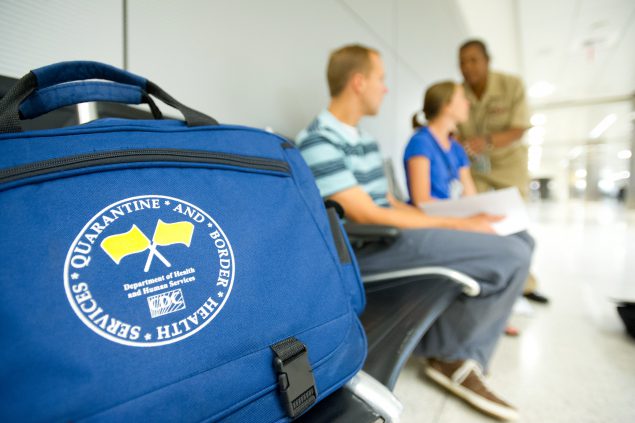
Credit: David Snyder
Disease is just a flight away. To protect America’s health, CDC partners with the Department of Homeland Security to prevent the spread of serious contagious diseases during travel. CDC uses a Do Not Board list to prevent travelers from boarding commercial airplanes if they are known or suspected to have a contagious disease that poses a threat to the public’s health. Sick travelers are also placed on a Lookout list so they will be detected if they attempt to enter the United States by land or sea. These tools can be used for anyone who poses a threat to the public’s health.
Local and state public health officials can request CDC’s assistance if a person who poses a public health threat intends to travel. CDC helps ensure these people do not travel while contagious.
Placing people on the lists
The criteria for adding people to the Do Not Board and Lookout lists are
- not aware of diagnosis or not following public health recommendations, or
- Likely to travel on a commercial flight involving the United States or travel internationally by any means; or
- Need to issue travel restriction to respond to a public health outbreak or to help enforce a public health order.
Criteria number one plus one of the three subsets must be met for a person to be placed on the Do Not Board and Lookout lists.
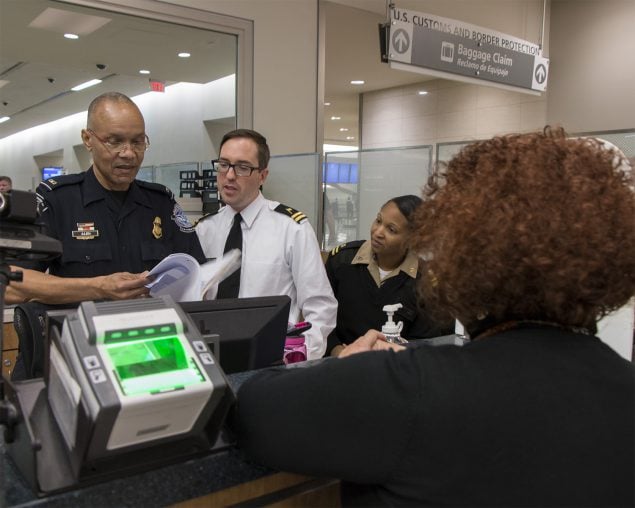
Credit: David Heaberlin
Once a person is placed on these lists, airlines will not issue a boarding pass to the person for any commercial flight within, arriving to, or departing from the United States.
The Do Not Board and Lookout lists have been used for people with suspected or confirmed infectious tuberculosis (TB), including multidrug-resistant tuberculosis (MDR-TB), and measles. During 2020-2022, CDC used these authorities to restrict travel of people with COVID-19 and close contacts who were recommended to quarantine. These authorities were also used for mpox during 2022. Travel restrictions can also be used for other suspected or confirmed contagious diseases that could pose a public health threat during travel, including viral hemorrhagic fevers such as Ebola.
Preventing people with contagious diseases from traveling also helps to make sure they get or continue medical treatment, such as for infectious tuberculosis.
Taking people off the lists
Once public health authorities confirm a person is no longer contagious, the person is removed from the lists (typically within 24 hours). Also, CDC reviews the records of all persons on the lists every two weeks to determine whether they are eligible for removal.
Frequently Asked Questions (FAQs) on Travel Restrictions to Prevent the Spread of Disease
- Importation
- Southern Border Health and Migration
- Travelers' Health
- Vessel Sanitation Program
- Funding and Guidance for State and Local Health Departments
- Emergency Preparedness and Response
- Division of Global Migration Health
Exit Notification / Disclaimer Policy
- The Centers for Disease Control and Prevention (CDC) cannot attest to the accuracy of a non-federal website.
- Linking to a non-federal website does not constitute an endorsement by CDC or any of its employees of the sponsors or the information and products presented on the website.
- You will be subject to the destination website's privacy policy when you follow the link.
- CDC is not responsible for Section 508 compliance (accessibility) on other federal or private website.
Policies to Promote Active Travel: Evidence from Reviews of the Literature
- Built Environment and Health (MJ Nieuwenhuijsen and AJ de Nazelle, Section Editors)
- Published: 10 July 2017
- Volume 4 , pages 278–285, ( 2017 )
Cite this article
- Meghan Winters 1 ,
- Ralph Buehler 2 &
- Thomas Götschi 3
4872 Accesses
103 Citations
24 Altmetric
Explore all metrics
Purpose of review
While many levels of government recognize that walking and cycling (active travel) are critical to healthy cities, a continued challenge is to identify and prioritize strategies that will increase walking and cycling for transportation. We review evidence on policies that can increase active travel.
Recent findings
The reviews included here conclude that policies related to active travel may operate at various levels of the socio-ecological framework, including society, cities, routes or individuals. The provision of convenient, safe and connected walking and cycling infrastructure is at the core of promoting active travel, but policies may work best when implemented in comprehensive packages.
There is strong evidence that active travel can result in substantial health benefits. However, there remains considerable uncertainty about the exact effects of specific policies on walking or cycling rates or safety. Further research is needed to quantify the impact of specific policies or packages of policies, especially across different settings or for different population segments.
This is a preview of subscription content, log in via an institution to check access.
Access this article
Price includes VAT (Russian Federation)
Instant access to the full article PDF.
Rent this article via DeepDyve
Institutional subscriptions
Similar content being viewed by others
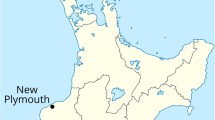
Increasing active travel: aims, methods and baseline measures of a quasi-experimental study
Ralph Chapman, Philippa Howden-Chapman, … Mark Grams

Built Environment Interventions to Increase Active Travel: a Critical Review and Discussion
Rachel Aldred
Towards a Comprehensive Conceptual Framework of Active Travel Behavior: a Review and Synthesis of Published Frameworks
Thomas Götschi, Audrey de Nazelle, … on behalf of the PASTA Consortium
Papers of particular interest, published recently, have been highlighted as: • Of importance •• Of major importance
Physical Activity Guidelines Advisory Committee. Physical activity guidelines advisory committee report, 2008. Washington, DC; 2008.
Kelly P, Kahlmeier S, Götschi T, Orsini N, Richards J, Roberts N, et al. Systematic review and meta-analysis of reduction in all-cause mortality from walking and cycling and shape of dose response relationship. Int J Behav Nutr Phys Act. 2014;11:132.
Article PubMed PubMed Central Google Scholar
Oja P, Titze S, Bauman A, de Geus B, Krenn P, Reger-Nash B, et al. Health benefits of cycling: a systematic review. Scand J Med Sci Sports. 2011;21:496–509.
Article PubMed CAS Google Scholar
Saunders LE, Green JM, Petticrew MP, Steinbach R, Roberts H. What are the health benefits of active travel? A systematic review of trials and cohort studies. PLoS One. 2013;8:e69912.
Article PubMed PubMed Central CAS Google Scholar
Woodcock J, Franco OH, Orsini N, Roberts I. Non-vigorous physical activity and all-cause mortality: systematic review and meta-analysis of cohort studies. Int J Epidemiol. 2011;40:121–38.
Article PubMed Google Scholar
Hamer M, Chida Y. Active commuting and cardiovascular risk: a meta-analytic review. Prev Med (Baltim). 2008;46:9–13.
Article Google Scholar
Hamer M, Chida Y. Walking and primary prevention: a meta-analysis of prospective cohort studies. Br J Sports Med. 2008;42:238–43.
Doorley R, Pakrashi V, Ghosh B. Quantifying the health impacts of active travel: assessment of methodologies. Transp Rev. 2015;35:559–82.
• Mueller N, Rojas-Rueda D, Cole-Hunter T, de Nazelle A, Dons E, Gerike R, et al. Health impact assessment of active transportation: a systematic review. Prev Med (Baltim). 2015;76:103–14. This study provides a systematic review of health impacts of active travel policies
Teschke K, Reynolds CCO, Ries FJ, Gouge B, Winters M. Bicycling: health risk or benefit? UBC Med J. 2012;3:6–11.
Google Scholar
FHWA. Our nation’s travel. Analysis of the 2009 NHTS. Washington, DC; 2010.
Statistics Canada. 2011 National Household Survey. In: Stat. Canada Cat. no. 99–012-X2011064. 2013. http://www12.statcan.gc.ca/census-recensement/2011/dp-pd/index-eng.cfm . Accessed 27 Feb 2017.
Bassett DR, Pucher J Jr, Buehler R, Thompson DL, Crouter SE. Walking, cycling, and obesity rates in Europe, North America, and Australia. J Phys Act Health. 2008;5:795–814.
Buehler R, Pucher J, Merom D, Bauman A. Active travel in Germany and the U.S.: contributions of daily walking and cycling to physical activity. Am J Prev Med. 2011;41:241–50.
•• Handy S, Van Wee B, Kroesen M. Promoting cycling for transport: research needs and challenges. Transp Rev. 2014;34:4–24. This review provides outlines the key questions facing bicycling research, and provides guidance to address the research needs
Hiatt R. An alternative to auto LOS for transportation impact analysis. Transp. Res. Board 85th Annu. Meet. 2006.
Shoup DC. The high cost of free parking. Updated ed. Chicago, IL: Planners Press, American Planning Association; 2011.
FHWA. Funding for highways and disposition of highway-user revenues, all units of government, 2012, Table HF 10. Federal Highway Association, US Dep. Transp. 2014.
Buehler R, Gotschi T, Winters M. Moving toward active transportation: how policies can encourage walking and bicycling. Active Living Research Brief. Released January 2016. http://activelivingresearch.org/ActiveTravelreview .
Krizek K, Forsyth A, Baum L. Walking and cycling international literature review. Victoria Dep. Transp. Melbourne, Aust; 2009.
Sallis J, Cervero R, Ascher W, Henderson K, Kraft M, Kerr J. An ecological approach to creating active living communities. Annu Rev Public Health. 2006;27:297–322.
Ewing R, Cervero R. Travel and the built environment: a meta-analysis. J Am Plan Assoc. 2010;76:265–94.
Larouche R. Built environment features that promote cycling in school-aged children. Curr Obes Rep. 2015;4:494–503.
Pucher J, Dill J, Handy S. Infrastructure, programs, and policies to increase bicycling: an international review. Prev Med. 2010;50:S106–25.
•• Buehler R, Dill J. Bikeway networks: a review of effects on cycling. Transp Rev. 2015;1647:1–19. Reviews evidence on the connection between cycling levels and different types of bikeway infrastructure—ranging from cycling in the road with traffic to separated bike paths
Fraser SDS, Lock K. Cycling for transport and public health: a systematic review of the effect of the environment on cycling. Eur J Pub Health. 2011;21:738–43.
Galvez MP, Pearl M, Yen IH. Childhood obesity and the built environment. Curr Opin Pediatr. 2010;22:202–7.
Heath GW, Brownson RC, Kruger J, Miles R, Powell KE, Ramsey LT. The effectiveness of urban design and land use and transport policies and practices to increase physical activity: a systematic review. J Phys Act Health. 2006;3:S55–76.
Larouche R, Saunders TJ, John Faulkner GE, Colley R, Tremblay M. Associations between active school transport and physical activity, body composition, and cardiovascular fitness: a systematic review of 68 studies. J Phys Act Health. 2014;11:206–27.
Macmillan AK, Hosking J, Connor JL, Bullen C, Ameratunga S. A Cochrane systematic review of the effectiveness of organisational travel plans: improving the evidence base for transport decisions. Transp Policy. 2013;29:249–56.
Hosking J, Macmillan A, Connor J, Bullen C, Ameratunga S. Organisational travel plans for improving health. Cochrane Database Syst Rev. 2010;3:CD005575.
Martin A, Suhrcke M, Ogilvie D. Financial incentives to promote active travel: an evidence review and economic framework. Am J Prev Med. 2012;43:e45–57.
Ogilvie D. Promoting walking and cycling as an alternative to using cars: systematic review. BMJ. 2004;329:763.
Ogilvie D, Foster CE, Rothnie H, Cavill N, Hamilton V, Fitzsimons CF, et al. Interventions to promote walking: systematic review. BMJ. 2007;334:–1204.
Rissel C, Curac N, Greenaway M, Bauman A. Physical activity associated with public transport use—a review and modelling of potential benefits. Int J Environ Res Public Health. 2012;9:2454–78.
Scheepers CE, Wendel-Vos GCW, den Broeder JM, van Kempen E, van Wesemael PJV, Schuit AJ. Shifting from car to active transport: a systematic review of the effectiveness of interventions. Transp Res Part A Policy Pract. 2014;70:264–80.
Yang L, Sahlqvist S, McMinn A, Griffin SJ, Ogilvie D. Interventions to promote cycling: systematic review. BMJ. 2010;341:c5293.
Cui Y, Mishra S, Welch TF. Land use effects on bicycle ridership: a framework for state planning agencies. J Transp Geogr. 2014;41:220–8.
Meddin R, DeMaio P. The bike-sharing world map. 2016. http://www.bikesharingmap.com/ . Accessed 27 Feb 2017.
Shaheen S, Martin E, Cohen A, Finson R. Public bikesharing in North America: early operator and user understanding. 2012.
Hamre A, Buehler R. Commuter mode choice and free car parking, public transportation benefits, showers/lockers, and bike parking at work: evidence from the Washington, DC Region. J Public Transp. 2014;17:67–91.
Hansen AY, Umstattd Meyer MR, Lenardson JD, Hartley D. Built environments and active living in rural and remote areas: a review of the literature. Curr Obes Rep. 2015;4:484–93.
Pucher J, Buehler R, Seinen M. Bicycling renaissance in North America? An update and re-appraisal of cycling trends and policies. Transp Res Part A Policy Pract. 2011;45:451–75.
Gase LN, Barragan NC, Simon PA, Jackson RJ, Kuo T. Public awareness of and support for infrastructure changes designed to increase walking and biking in Los Angeles County. Prev Med (Baltim). 2015;72:70–5.
Alliance for Biking & Walking. Bicycling and walking in the United States: 2016 benchmarking report; 2016.
Elvik R. The non-linearity of risk and the promotion of environmentally sustainable transport. Accid Anal Prev. 2009;41:849–55.
Jacobsen P. Safety in numbers: more walkers and bicyclists, safer walking and bicycling. Inj Prev. 2003;9:205–9.
Jacobsen PL, Ragland DR, Komanoff C. Safety in numbers for walkers and bicyclists: exploring the mechanisms. Inj Prev. 2015;21:217–20.
•• Götschi T, Garrard J, Giles-Corti B. Cycling as a part of daily life: a review of health perspectives. Transp Rev. 2016;36:45–71. This study reviews the most relevant links between cycling and health and presents research approaches and needs, many of which apply equally to walking
Cavill N, Muller L, Mulhall C, Harold K, Kennedy A, Hillsdon M, et al. Cycling demonstration towns: surveys of cycling and physical activity 2006 to 2009. London, Engl Cycl Engl. 2009.
Litman T. Quantifying the benefits of nonmotorized transportation for achieving mobility management objectives. Transp Res Rec. 2004;1441:134–40.
Sallis J, Spoon C, Cavill N, et al. Co-benefits of designing communities for active living: an exploration of literature. Int J Behav Nutr Phys Act. 2015;12:30.
Brown V, Diomedi BZ, Moodie M, Veerman JL, Carter R. A systematic review of economic analyses of active transport interventions that include physical activity benefits. Transp Policy. 2016;45:190–208.
Ogilvie D, Bull F, Cooper A, et al. Evaluating the travel, physical activity and carbon impacts of a ‘natural experiment’ in the provision of new walking and cycling infrastructure: methods for the core module of the iConnect study. BMJ Open. 2012;2:e000694.
Mayne SL, Auchincloss AH, Michael YL. Impact of policy and built environment changes on obesity-related outcomes: a systematic review of naturally occurring experiments. Obes Rev. 2015;16:362–75.
Download references
Acknowledgments
This manuscript is based on a research brief prepared by the authors for Active Living Research, with funding from the Robert Wood Johnson Foundation. We would like to acknowledge Prabhu Ponkshe, Jim Sallis, David R. Bassett, Jr., Sean Co, Ruth L. Steiner and other Robert Wood Johnson staff for their valuable feedback and contributions as part of the research brief. We also acknowledge Kyle Lukacs for his help collecting and organizing the literature and thank the Metropolitan Institute at Virginia Tech for financially supporting Lukacs’ work. We also acknowledge Moreno Zanotto for assistance with manuscript preparation.
Author information
Authors and affiliations.
Faculty of Health Sciences, Simon Fraser University, Blusson Hall Rm 11522, 8888 University Drive, Burnaby, B.C., V5A 1S6, Canada
Meghan Winters
School of Public and International Affairs, Virginia Tech, 1021 Prince Street, Suite 200, Alexandria, VA, 22301, USA
Ralph Buehler
Epidemiology, Biostatistics and Prevention Institute, University of Zurich, Hirschengraben 84, CH-8001, Zurich, Switzerland
Thomas Götschi
You can also search for this author in PubMed Google Scholar
Corresponding author
Correspondence to Meghan Winters .
Ethics declarations
Conflict of interest.
Meghan Winters, Thomas Götschi and Ralph Buehler declare that they have no conflict of interest.
Human and Animal Rights and Informed Consent
This article does not contain any studies with human or animal subjects performed by any of the authors.
Additional information
This article is part of the Topical Collection on Built Environment and Health
Rights and permissions
Reprints and permissions
About this article
Winters, M., Buehler, R. & Götschi, T. Policies to Promote Active Travel: Evidence from Reviews of the Literature. Curr Envir Health Rpt 4 , 278–285 (2017). https://doi.org/10.1007/s40572-017-0148-x
Download citation
Published : 10 July 2017
Issue Date : September 2017
DOI : https://doi.org/10.1007/s40572-017-0148-x
Share this article
Anyone you share the following link with will be able to read this content:
Sorry, a shareable link is not currently available for this article.
Provided by the Springer Nature SharedIt content-sharing initiative
- Active travel
Advertisement
- Find a journal
- Publish with us
- Track your research
GOV.WALES uses cookies which are essential for the site to work. Non-essential cookies are also used to tailor and improve services. By continuing to use this site, you agree to our use of cookies.

Active Travel Act guidance
Guidance for local authorities planning and designing networks of walking and cycling routes.
Read details on this page
- Active Travel Act: guidance and forms and
- Walking and cycling (Sub-topic)
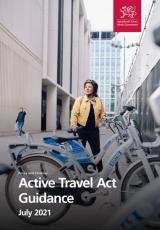
Active Travel Act guidance , file type: PDF, file size: 43 MB
Includes best practice on infrastructure design and gives guidance on how to provide related facilities such as cycle parking.
First published
Last updated, share this page.
- Share this page via Twitter
- Share this page via Facebook
- Share this page via Email
- Advanced search
- Peer review
- Collections
- University of Westminster Press
Active Travel Studies
Active Travel Studies is a peer-reviewed, open access journal publishing authoritative research on walking, cycling and other forms of active travel. In the context of a climate emergency, widespread health problems associated with inactvitity, and poor air quality caused in large part by fossil-fuel transport, this journal is relevant and timely. As well as informing the research agenda, it will provide practitioners and policymakers with access to current and robust findings on all subject relevant to active travel.
Based on high academic standards, and providing a bridge between research and practice, the journal's remit is to share knowledge, from any academic discipline, from bioscience to anthropology, that can contribute to building knowledge to support active travel and remove barriers to it. (publ. by University of Westminster Press)

Focus and Scope
We live in times of climate crisis, with illegal levels of air pollution in many cities worldwide, and what has been called an epidemic of physical inactivity. Technological change alone will not solve such problems: we also need major growth in active travel (primarily walking and cycling, but also other active and semi-active types of travel, such as scooters) to replace many shorter car trips. Active modes could even (e.g. through electric assist trikes) help make urban freight much more sustainable.
Journals within many fields cover active travel, but literature remains highly segmented and (despite high levels of policy interest) difficult for practitioners to find. Established, mainstream journals are not open access, another barrier to policy transfer and knowledge exchange. Thus, while many towns, cities, and countries seek to increase active travel, the knowledge base suffers from a lack of high-quality academic evidence that is easy to find and obtain. This reinforces practitioner reliance on often lower-quality grey literature, and a culture of relying on ad hoc case studies in policy and practice.
This journal provides a bridge between academia and practice, based on high academic standards and accessibility to practitioners. Its remit is to share knowledge from any academic discipline/s (from bioscience to anthropology) that can help build knowledge to support active travel and help remove barriers to it, such as car dependency. Within this normative orientation, it is rigorously academic and critical, for instance not shying away from analysing examples where interventions do not lead to more active travel. It goes beyond immediate policy imperatives to share knowledge that while not immediately change-oriented can contribute to a deeper understanding of, for instance, why people drive rather than walk.
As well as publishing relevant new research, the journal commissions both commentary pieces on such research, and critical reviews of the existing literature. Reflecting the diversity of its audience, its content is varied, including written work of different lengths as well as audio-visual material
Publication Frequency
The journal is published online as a continuous volume and issue throughout the year. Articles are published as soon as they are ready to ensure that there are no unnecessary delays in making content publicly available.
Special collections of accepted submissions are welcomed welcomed and a webpage will be dedicated to each collection. The individual submissions will also be published alongside the journal’s other content.
Open Access Policy
This journal operates under Diamond Open Access, meaning there are no charges for either publication in the journal or readership of its content. The journal provides immediate open access to its content on the principle that making research freely available to the public supports the global exchange of knowledge.
Authors of published material remain the copyright holders and grant third parties the right to use, reproduce, and share the article according to the Creative Commons licence agreement.
Archiving Policy
The journal’s publisher focuses on making content discoverable and accessible through indexing services. Content is also archived around the world to ensure long-term availability.
In addition, the journal is available for harvesting via OAI-PMH .
To ensure permanency of all publications, this journal also utilises CLOCKSS , and LOCKSS archiving systems.
If the journal is not indexed by your preferred service, please contact us or, if you prefer, make an indexing request directly with the service.
Active Travel Studies is published with the support of the University of Westminster and the Quintin Hogg Trust.
- Quintin Hogg Trust
- University of Westminster
Editorial Team
Tom Cohen Active Travel Academy, University of Westminster, UK Website
Deputy Editor
Rachel Aldred
Editorial Assistant
Luz Navarro Eslava
Editorial Board
Sonja Haustein Technical University of Denmark View Profile Website Twitter Linkedin
Esther Anaya Boig Imperial College London, UK Website Twitter Github Linkedin
Giulio Mattioli
Tim Jones Oxford Brookes University, UK View Profile Website
Ersilia Verlinghieri University of Westminster, UK
Jamie Furlong University of Westminster, UK
Author Guidelines
Submissions should be made electronically through this website. Once submitted, the author can track the submission and communicate with the editors via the online journal management system.
Please ensure that you consider the following guidelines when preparing your manuscript. Failure to do so may delay processing your submission.
Article types
- Research articles must describe the outcomes and application of unpublished original research. These should make a substantial contribution to knowledge and understanding in the subject matter and should be supported by relevant figures and tabulated data. Research articles should be no more than 8,000 words in length.
- Commentaries should reflect upon or critique a specific "happening" such as a release of a major study or other notable occurrence related to journal focus. Authors interested in submitting a commentary piece should discuss the content with the editor before submitting a manuscript. Commentary articles should be no longer than 3,000 words in length.
- Reviews can cover topics such as current controversies or the historical development of studies as well as issues of regional or temporal focus. Papers should critically engage with the relevant body of extant literature. Review articles should be no longer than 8,000 words in length.
- Debates should allow a range of views on a subject relevant to the journal’s focus to be aired in a lively manner by at least two authors taking contrasting positions and reacting to each other’s interventions, referring to the literature as appropriate. Debate articles should be no more than 5,000 words in length.
- Interviews will present the opinions of influential figures from the world of active travel and associated fields through the medium of interview conducted by knowledgeable researchers. Participants can write their answers to questions or can be interviewed conventionally, subject to subsequent editing to ensure the final text achieves the journal’s standards of precision and clarity. Interviews must not exceed 5,000 words in length.
- Viewpoints will offer informed analysis and critical views surrounding key and emerging issues in active travel research with suggestions for future directions as well as comment on emerging trends in the literature. These may be of length 3,500 to 8000 words in length.
All word limits include referencing and citation.
For further details please follow below links:
Article types | Structure | Permissions | Language & text | Data & Symbols | Figures & Tables | References
Research Integrity
Anti-plagiarism checking.
A combination of pre-screening and open access is the best possible defence against plagiarism. All articles submitted to University of Westminster Press journals are automatically screened for plagiarism by the CrossCheck system from CrossRef. This system compares incoming articles to a large database of academic content, and alerts editors to any possible issues.
Rigorous Peer Review
University of Westminster Press ensures that all research output, in both journals and books, is thoroughly peer reviewed by external reviewers, and offers the option of open peer review if required. Publications of a commentary or opinion nature may not be sent for external peer review but will include extensive editorial review and revisions. All of our journals adhere to the COPE guidelines for best practice .
Open Licences
All University of Westminster Press content is released under open licences from Creative Commons . We believe that only CC BY meets the requirements for true open access for journals, and strongly prefer CC0 for open research data.
The journals supports the Budapest Open Access Initiative , which states that open access “…will accelerate research, enrich education, share the learning of the rich with the poor and the poor with the rich, make this literature as useful as it can be, and lay the foundation for uniting humanity in a common intellectual conversation and quest for knowledge.”
Active Travel Studies endorses the Panton Principles , which state that "for science to effectively function, and for society to reap the full benefits from scientific endeavours, it is crucial that science data be made open."
Research Data
All University of Westminster Press journals and books strongly encourage authors to make the research objects associated with their publications openly available. This includes research data, software, bioresources and methodologies. This means that peer reviewers are better able to assess the foundations of claims made, and the research community and wider public are similarly able to validate authors’ work, and are more easily able to extend and build upon it.
All journals and books can be integrated with their own repository on the Dataverse Network as standard, and additional integration with subject-specific repositories such as Dryad is implemented on request.
All University of Westminster Press content is indexed with CrossRef and assigned a Digital Object Identifier (DOI) . This means that all of our references are made available so that citations can be tracked by the publishing community, and the content is added to the Cross-Check anti-plagiarism database.
All of our article metadata is openly available for harvesting by indexing services via OAI-PMH and the journals are registered with Open Archives .
For more information on where this journal is indexed, please view the journal's about page.
As members of CLOCKSS (Controlled Lots of Copies Keep Stuff Safe) our content is regularly archived with many of the world's leading research libraries. The CLOCKSS archive ensures that University of Westminster Press content will always be made available as open access, in any eventuality.
Where relevant we automatically archive journal and book content with subject specific archives such as PubMed Central or Europe PMC / PMC Bookshelf .
We fully support and encourage author self-archiving of all content (sometimes termed 'green' open access). All University of Westminster Press journals are registered with SHERPA/RoMEO to ensure that the licence terms and self-archiving policies of the journals are 100% clear.
The University of Westminster Press uses open, non-proprietary standards for all of its content, meaning that it can be easily transferred to archives and other publishers. All of our article XML is compliant with the Journal Archiving Tag Suite (JATS) schema.
We endorse and adhere to the NISO Transfer Code of Practice , which ensures that, when a journal transfers between publishers, librarians, editors, and other publishers are informed and treated fairly.
All copyright to the published content is retained by the authors, University of Westminster Press does not retain rights to the published content and the content can be transferred away from University of Westminster Press if the editors decide to change publisher.
Journal Representatives
Principal contact - editor.
Dr Tom Cohen
Technical Support
Support Contact
Professor Rachel Aldred
For inquiries, kindly get in touch here via the ATS contact form
- Record : found
- Orcid : found
- Profile : found
ScienceOpen Admin
Philippa Grand
Collection information, latest articles 41 .
- Discipline Hopping for Environmental Solutions: An Art-Science Collaboration Authors: Clare Nattress , Daniel Bryant
- Perceptions of E-Micromobility Vehicles Amongst Staff and Students at Universities in the North of England Authors: Gemma Bridge
- Active Travel in Rural New Zealand: A Study of Rural Adolescents’ Perceptions of Walking and Cycling to School Authors: Debbie Hopkins , Enrique García Bengoechea , Kirsten Coppell …
Twitter feed
Situation in Haiti March 29, 2024
U.s. citizens in haiti, update january 10, 2024, information for u.s. citizens in the middle east.
- Travel Advisories |
- Contact Us |
- MyTravelGov |
Find U.S. Embassies & Consulates
Travel.state.gov, congressional liaison, special issuance agency, u.s. passports, international travel, intercountry adoption, international parental child abduction, records and authentications, popular links, travel advisories, mytravelgov, stay connected, legal resources, legal information, info for u.s. law enforcement, replace or certify documents.
Share this page:
Learn about your destination
Take 90 seconds for safer travel.
Travel Advisory Levels
Enroll in step.

Subscribe to get up-to-date safety and security information and help us reach you in an emergency abroad.
Recommended Web Browsers: Microsoft Edge or Google Chrome.
External Link
You are about to leave travel.state.gov for an external website that is not maintained by the U.S. Department of State.
Links to external websites are provided as a convenience and should not be construed as an endorsement by the U.S. Department of State of the views or products contained therein. If you wish to remain on travel.state.gov, click the "cancel" message.
You are about to visit:
- Media Centre
Find out what we stand for and how our work around the UK is making a difference.
- Board of Trustees
- Paths for Everyone
- In Scotland
- In Northern Ireland
Explore fantastic walking and cycling routes across the UK
Information
- Find a route on the Network
- About the National Cycle Network
- Our future vision
- Find other cycle routes
Inspiration
- Route collections
- Great walks on the Network
- Traffic-free family rides
- Making space for nature on the Network
For professionals
Work in partnership with us to tackle the challenges of congestion, air pollution, physical inactivity, and social inequality, by making it easier for people to walk and cycle.
Policy area
Policy positions
- The Walking and Cycling Index
- Streets for everyone
Disabled Citizens' Inquiry
Sector experience.
- Cycling infrastructure
- Urban design and planning
- Research, monitoring and evaluation
- Our approach
Get involved
Your support helps to give children access to the training and equipment they need to ride a bike safely - starting a cycle of good that can go on to benefit their health, education and future.
- Leave a gift in your Will
- Donate in memory
- Corporate partnerships
- Give a virtual gift
Give your time
- Work for Sustrans
- Log in to Assemble
- Fundraising and challenge events
- Become a Sustrans fundraiser
We're working to improve everyday journeys for everyone. We make contributions that assist in the development of all official active travel policy and guidance.
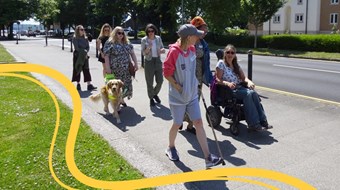
Bringing disabled people’s voices into the heart of decision-making can improve walking and wheeling for everyone.
Find out more about disabled people’s experiences of walking and wheeling in the UK, and how we can make our places and transport more inclusive and accessible.
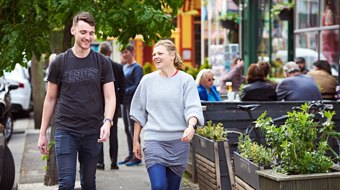
Walkable neighbourhoods: how to reduce car dependency in new development.
We surveyed 100 local planning authorities in England (outside London) to ask them about how they allocate sites for development.
Find out about the research results and our recomendations
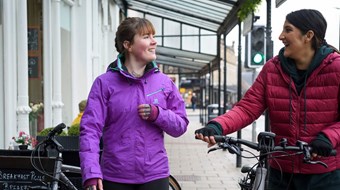
Ensuring walking and cycling is for everyone
Take a look at our information and guidance:
- Cycling for everyone
- Tools and resources to help make walking and cycling for everyone
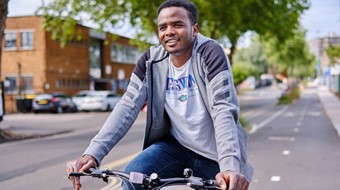
Life after lockdown: Our policy briefing series
We explore how the Covid-19 pandemic is affecting people in relation to transport and movement, and neighbourhoods and places in this series of briefing papers.
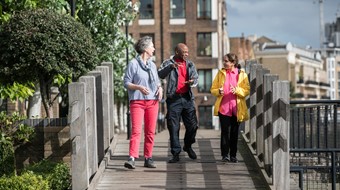
Spatial planning reform
We’re working as part of the Better Planning Coalition to seek revisions to the National Planning Policy Framework. We’re calling for changes to spatial planning policy in England because the planning system has a vital role to play in creating places which enable everyone to live healthier, happier lives.
Read our six proposed amendments
Our position on UK policies
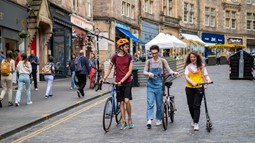
Our position on 20-minute neighbourhoods
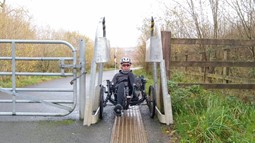
Our position on access controls for walking and cycling paths
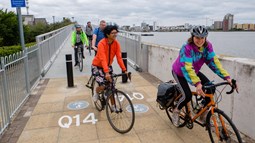
Our position on the use of cycle helmets

Our position on personal safety
Read our latest research
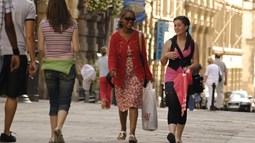
Why we need to change direction on building homes
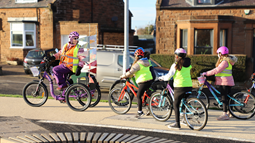
School behaviour change interventions result in more young people walking and cycling, new report finds
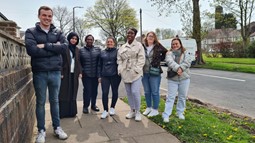
Moving around: Findings from a dialogue on walking and cycling
By Jamie Hearing
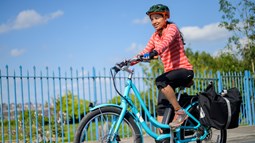
Analysing the success of the E-Move community e-cycle project
See our latest policy consultation submissions
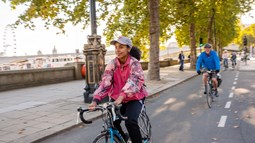
Policy consultation submissions
Our response to the Battersea Bridge safety improvements scheme
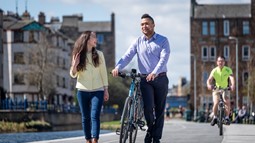
Our response to the Scottish Government’s 20% Car reduction route map consultation
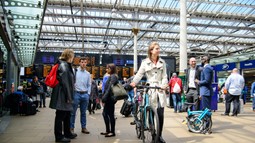
Our response to the Scottish Government’s STPR2 consultation

Our response to the Scottish Government’s NPF4 consultation
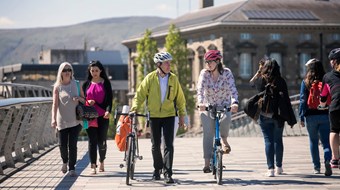
Making the case for active travel
We have research, guides, resources, tools and case studies to make the case for and improve walking and cycling schemes.
- Air quality
- Active travel statistics
- Active Travel Toolbox
- Bike Life: an assessment of cycling in cities
- Evaluating cycling in towns and cities
- Tackling physical inactivity
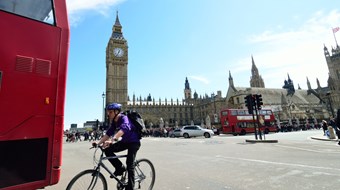
Parliamentary champions
Our parliamentary champions believe in and advocate for the right of every child to be able to walk, cycle and scoot to school safely.
Is your MP on the list?
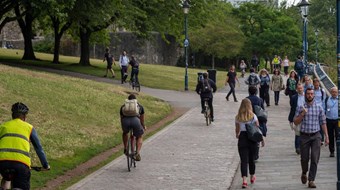
Policy Scan
Sustrans Policy Scan is a regular summary of key policy thinking, reports, announcements and consultations
Sign up to our business newsletter
Read opinion articles by our experts.

Active Travel Investment Programme
What is active travel.
Active Travel involves travelling with a purpose, using your own energy via sustainable means. It includes walking, wheeling, and cycling or the use of self-powered, non-motorised scooters as part of a purposeful journey. For example, walking to school and cycling to work are both considered forms of Active Travel.
What role does the NTA have in Active Travel?
The NTA has a dedicated Active Travel team who work in collaboration with Local Authorities across the country on the delivery of hundreds of Active Travel projects. This includes the development of segregated cycle lanes and widened footpaths, new walking and cycling bridges, and new pedestrian crossings.
The work of the NTA’s Active Travel Programme is underpinned by the aims and objectives set out in the Government’s Climate Action Plan 2023 . One of the key aims cited is to increase the number of walking and cycling networks so that walking, cycling and public transport will account for 50% of all journeys made by 2030.
Projects are funded by the Department of Transport through the National Transport Authority’s Active Travel Programme and are managed and delivered by the Local Authorities. In 2023, 290 million euros was allocated by the NTA to enhance the delivery of hundreds of projects including a new cycle and pedestrian bridge over the N40 in Cork, connecting to Tramore Valley Park, and the connection of the Waterford Greenway from Bilberry into the heart of Waterford City Centre.
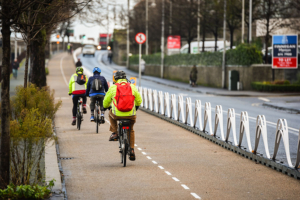
By 2025, the NTA aims to have delivered in excess of 1,200 projects equating to 1,000km of combined cycling and walking routes nationwide.
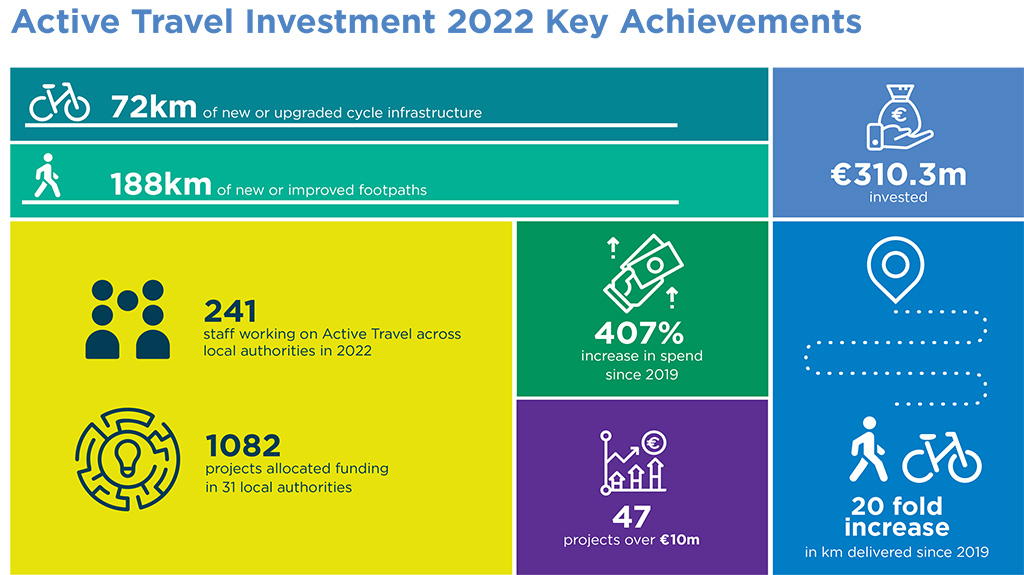
News: Latest Active Travel news
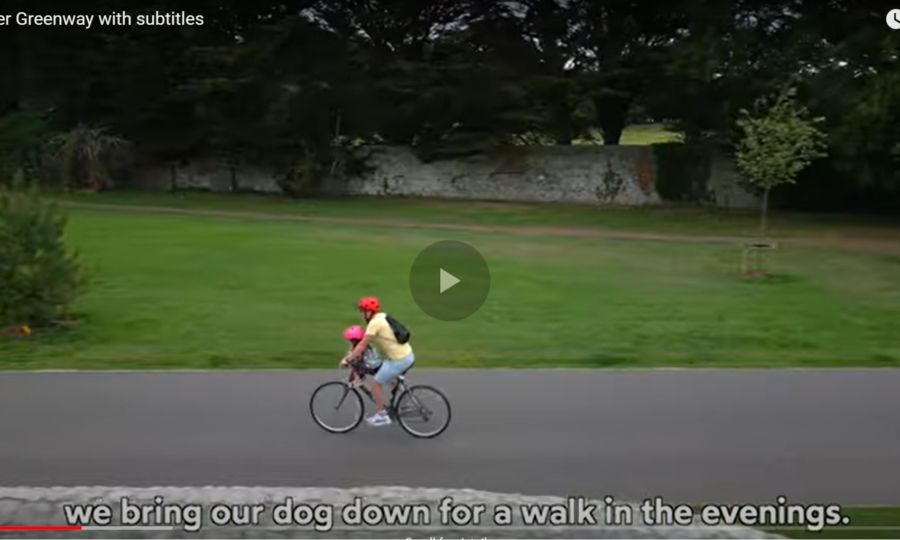
Watch: Active Travel case study videos

CycleConnects – Ireland’s Cycle Network – Active Travel
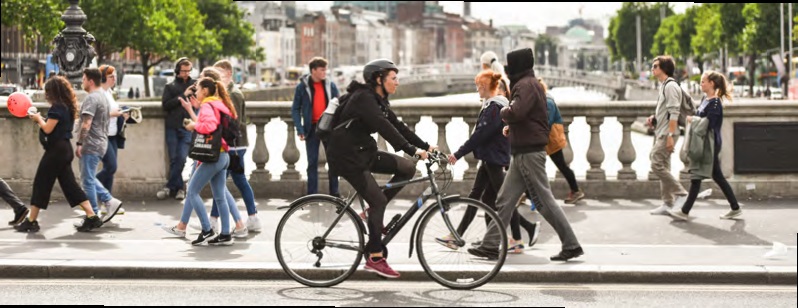
2023 Active Travel Grants Allocation County by County
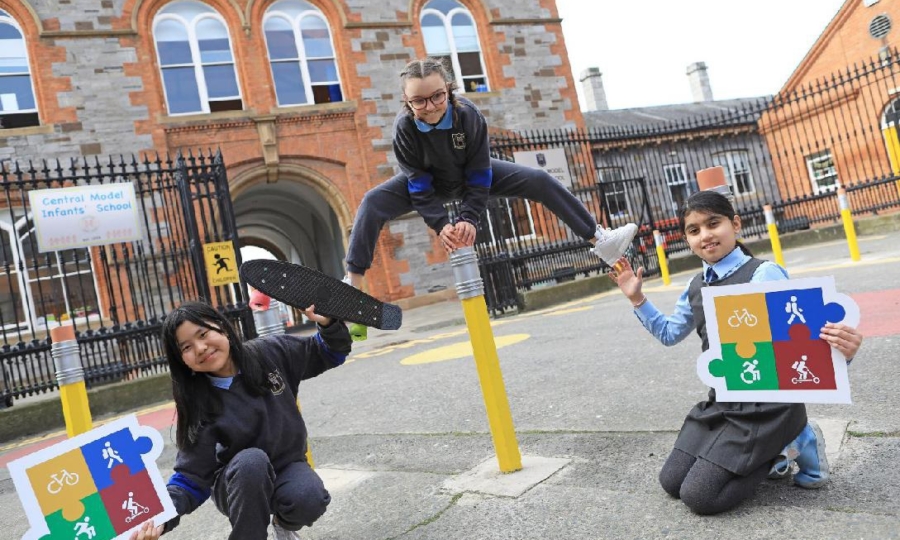
Safe Routes to School (SRTS) Programme
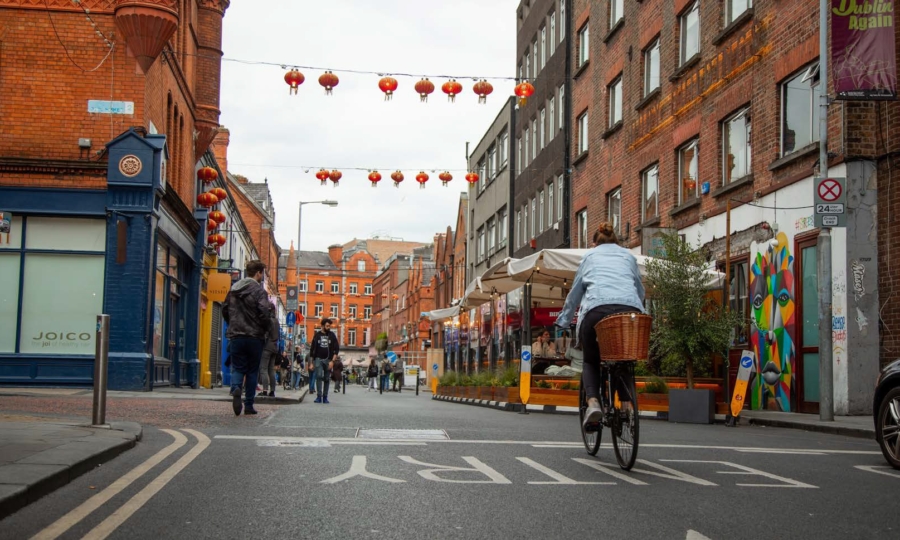
NTA Active Travel Publications
Baltimore Port: What impact will bridge collapse have on shipping?

PORT FEATURES
Current status of cargo ships inside port, cruise ships, london metal exchange warehouses, bunker fuel.
Get weekly news and analysis on the U.S. elections and how it matters to the world with the newsletter On the Campaign Trail. Sign up here.
Reporting by Josephine Mason, Nick Carey, Helen Reid, Jonathan Saul, Nigel Hunt, Marwa Rashad, Scott DiSavino, Shariq Khan and Eric Onstad; Compiled by Josephine Mason and Nina Chestney; Editing by Nick Macfie and Nick Zieminski
Our Standards: The Thomson Reuters Trust Principles. , opens new tab

Border police in ex-Soviet Moldova said on Thursday they had found and cordoned off what appeared to be fragments of an Iranian-made Russian drone just inside the country's border with Ukraine.
Ecuador's government declared Mexico's ambassador to the country unwelcome due to what it cited as "unfortunate" comments from the Mexican president about the South American country's elections last year, officials announced on Thursday.


IMAGES
COMMENTS
Active Travel Toolbox: a collection of guides, tools and case studies to help local authorities deliver walking and cycling schemes in their area. Active Mode Appraisal Toolkit: a spreadsheet ...
A wider definition of active travel. Seeking to extend the scope of active travel and broaden horizons beyond walking and cycling, we tentatively offer this wider and more inclusive working definition of active travel: Travel in which the sustained physical exertion of the traveller directly contributes to their motion.
The Do Not Board and Lookout lists have been used for people with suspected or confirmed infectious tuberculosis (TB), including multidrug-resistant tuberculosis (MDR-TB), and measles. During 2020-2022, CDC used these authorities to restrict travel of people with COVID-19 and close contacts who were recommended to quarantine.
There have been noteworthy increases in active travel including cities that would generally be considered car-centric (i.e. Minneapolis, Denver, Miami or Los Angeles) which suggests that there are not unsurmountable contextual factors that inhibit a city from increasing active travel, given sufficient pro-active policy environments [43,44,45].
CNN —. US travel restrictions instituted in the early months of the Covid-19 pandemic by states have been eliminated. However, the US Centers of Disease Control and Prevention suggests delaying ...
Over a week, activity should add up to at least 150 minutes (21⁄2 hours) of moderate intensity activity in bouts of ten minutes or more. all adults should undertake physical activity to improve muscle strength on at least two days a week and, for those at risk of falls, two sessions of balance and co-ordination exercise a week.
1.1 This advice note has been prepared by Active Travel England (ATE), a new statutory consultee in the planning system to help support local planning authorities (LPAs) in their role as decision makers for planning applications. It is specifically intended for LPAs outside of London, with a separate advice note prepared for planning ...
Active Travel Act: guidance and forms and ; Walking and cycling (Sub-topic) First published: 16 July 2021. Last updated: 16 July 2021. Documents. Active Travel Act guidance, file type: PDF, file size: 43 MB . PDF. 43 MB. If you need a more accessible version of this document please email [email protected]. Please tell us the format you need.
Conclusions and recommendations. 1. Active Travel England has made good early progress but it is still early days for the new organisation. DfT set-up Active Travel England (ATE) in August 2022 to deliver its walking and cycling strategy and to address long-standing issues such as the need to improving the quality of active travel infrastructure and local authorities' capability to deliver.
Active travel means making journeys by physically active means, like walking or cycling. The Cycling and Walking Investment Strategy, published in 2017, is the Government's strategy to promote walking and cycling in England. Given active travel is a devolved policy area, this briefing relates primarily to active travel policies in England.
Sustainable urban transport and active travel policies have the potential to positively and negatively impact health. They are critical to building healthy cities since they impact health determinants such as physical activity, air quality, noise, road safety, green spaces, social interaction and access to healthcare services.
Active Travel Studies is a peer-reviewed, open access journal publishing authoritative research on walking, cycling and other forms of active travel. In the context of a climate emergency, widespread health problems associated with inactvitity, and poor air quality caused in large part by fossil-fuel transport, this journal is relevant and timely.
× External Link. You are about to leave travel.state.gov for an external website that is not maintained by the U.S. Department of State. Links to external websites are provided as a convenience and should not be construed as an endorsement by the U.S. Department of State of the views or products contained therein.
What Active Travel is. The Department of Transport defines Active Travel as 'travelling with a purpose, using your own energy'. Walking, cycling, wheeling and using a non-motorised scooter to make journeys to work, school or the shops, for example, are all considered forms of Active Travel. Policies relating to recreational walking and ...
Making the case for active travel. We have research, guides, resources, tools and case studies to make the case for and improve walking and cycling schemes. Air quality; Active travel statistics; Active Travel Toolbox; Bike Life: an assessment of cycling in cities; Evaluating cycling in towns and cities; Tackling physical inactivity
The work of the NTA's Active Travel Programme is underpinned by the aims and objectives set out in the Government's Climate Action Plan 2023. One of the key aims cited is to increase the number of walking and cycling networks so that walking, cycling and public transport will account for 50% of all journeys made by 2030.
Joint Travel Regulations. The Joint Travel Regulations (JTR) implements policy and law to establish travel and transportation allowances for Uniformed Service members (i.e., Army, Navy, Air Force, Marine Corps, Space Force, Coast Guard, National Oceanic and Atmospheric Administration Commissioned Corps, and Public Health Service Commissioned Corps), Department of Defense (DoD) civilian ...
A review of the national policies with relevance to active travel is included to assist with policy reviews within active travel strategies and framing how enabling active travel can help meet multiple policy objectives. Implications for specific measures or processes that it would be valuable to include in Active Travel Strategies are highlighted.
guidelines, standards, roads, greenways and active travel. Currently there are a range of approved standards and guidelines for use which are primarily published by the Transport Infrastructure Ireland (TII), the National Transport Authority (NTA) and the Department of Transport (DoT) with the following as specific requirements: -
GovTravels 2024 exhibit hall. On February 28, 2024, the Defense Travel Management Office and our co-sponsor the National Defense Transportation Association, wrapped up another successful three-day GovTravels Symposium with over 1,125 attendees from across the U.S. Government and the commercial travel industry.
A major bridge collapsed in the U.S. port of Baltimore in the early hours of Tuesday after being struck by a container ship, plunging cars into the river below.